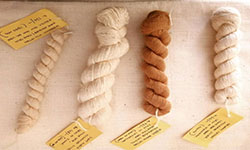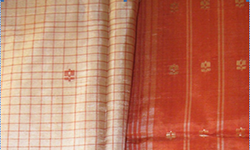
Advocacy, Case Studies, Craftspersons/ Artisanal, Employment/ Livelihood
Reconstructing Indigenous Cotton Ecosystem
Satish, Poludas Nagendra
Issue 10,Summer 2023
Issue #10, 2023 ISSN: 2581- 9410
In the jurisdiction of design and production, there exists a contradiction that demands our immediate attention. As a design initiative, we keep designing products and mass produce them. What will happen to every product created, and where will they end up in 10–20 years or even longer? Few people can say we recycle. Can we recycle for a few more cycles after that? The answer would be waste generation. When we develop something, it could initially appear to be beautiful, but sooner or later it will end up as waste material dumped somewhere in the globe.
So, it has become necessary to think about "slow," "sensible," and "sustainable" means of existence and modes of production.
 Hill Cotton Cultivation at Nimmalavalasa village, Srikakulam District
Desi cotton farming, hand spinning, hand processing, inexpensive indigenous technologies, and hand weaving are the finest examples of such alternatives. These methods not only encourage sustainable practises but also provide opportunities for livelihood. Additionally, you stress the importance of funding research and development, particularly with regard to domestic cotton production. Focusing on regionally grown cotton with low energy requirements and de...
Hill Cotton Cultivation at Nimmalavalasa village, Srikakulam District
Desi cotton farming, hand spinning, hand processing, inexpensive indigenous technologies, and hand weaving are the finest examples of such alternatives. These methods not only encourage sustainable practises but also provide opportunities for livelihood. Additionally, you stress the importance of funding research and development, particularly with regard to domestic cotton production. Focusing on regionally grown cotton with low energy requirements and de...
 Hill Cotton Cultivation at Nimmalavalasa village, Srikakulam District
Desi cotton farming, hand spinning, hand processing, inexpensive indigenous technologies, and hand weaving are the finest examples of such alternatives. These methods not only encourage sustainable practises but also provide opportunities for livelihood. Additionally, you stress the importance of funding research and development, particularly with regard to domestic cotton production. Focusing on regionally grown cotton with low energy requirements and de...
Hill Cotton Cultivation at Nimmalavalasa village, Srikakulam District
Desi cotton farming, hand spinning, hand processing, inexpensive indigenous technologies, and hand weaving are the finest examples of such alternatives. These methods not only encourage sustainable practises but also provide opportunities for livelihood. Additionally, you stress the importance of funding research and development, particularly with regard to domestic cotton production. Focusing on regionally grown cotton with low energy requirements and de...
This is a preview. To access all the essays on the Global InCH Journal a modest subscription cost is being levied to cover costs of hosting, editing, peer reviewing etc. To subscribe, Click Here.



